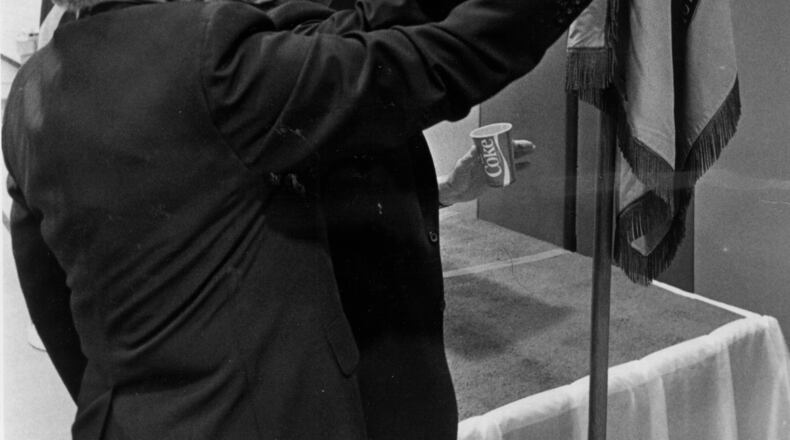When I received notice of the final all-class reunion for historic Atlanta Boys High, I went to our AJC archives to learn more about this legendary high school. The first few hundred references to the school were all in obituaries of notable graduates.
And therein lies the problem.
Fewer and fewer graduates remain from the all boys high school that produced some of Georgia’s most influential leaders before it shut its doors in 1947. That year, Atlanta closed Boys High, its arch rival Tech High and its female counterpart Girls High to create a new neighborhood school, Grady High School.
That is why Friday will mark the last reunion of all classes. About 130 people are expected at the Cherokee Town Club luncheon in Buckhead, 75 of whom are alumni.
In describing this final all-class event, which will feature Grady High principal Betsy Bockman, organizer Herman Mitchell said:
This is the last hoorah. Because of attrition and the age of the alumni, this will be the last all-class reunion. As our current alumni association president Tommy Tillman put it, "All good things come to an end."
The school has held reunions for 35 years, starting in 1983. Boys' High closed with its last graduating class in June 1947, as the City of Atlanta made all the high schools co-ed.
The school was originally established on Jan. 30, 1872, as an all-male educational institution. During the 75 years the school was open, it provided more than 7,000 students with an excellent college preparatory education.
The Alumni Association still has almost 300 active and alive members all over the country. This seems a goodly number as the youngest graduates are now 87 to 89.
At the end of the luncheon, our old guys will stand and sing our fight song, "On To Victory."
The AJC has covered several past reunions of Boys High. I spent the morning reading the old stories. (Please note the grammatical divide between Boys' High and Boys High in news articles. I opted for Boys High here.)
Boys High had only 24 students when it opened in downtown Atlanta 146 years ago, moving eight times before settling in at what’s now Grady High. At its peak, Boys High housed more than 1,000 students, almost all of whom went onto college.
Here are excerpts from some of those stories over the years to give you a sense of what Boys High meant to Georgia history.
From a 2004 AJC story:
Boys High played in the Orange Bowl and the Gator Bowl during its reign over Southern high school football in the 1930s and '40s, but the school's natural enemy was across the hall.
Tech High, Atlanta's other all-male high school and a football power in its own right, was housed at the same Midtown address from 1924 to its 1947 closing.
"It was Boys left, Tech right,'' said Phillip Maffett, president of the Boys High School Alumni Association. "We met in the hallway but didn't have anything to do with each other. There was one flag pole in the middle of the building for both schools, and somebody from Tech put up a [metal] flag one time and greased the pole. A shotgun brought it down.''
The bullet-ridden proof is on display at the Atlanta History Center.
What survives of Boys High School's sports heritage, the nine football state championships and a giant of a coach named R.L. "Shorty" Doyal, lives mostly in the hearts of sentimental men such as Maffett, Charlie Whitt and Larry Doyal. Their Boys High School Alumni Association, which conferred $17,000 in academic scholarships this year, will Saturday receive the Sam Burke Award for a lifetime of service from the Georgia Athletic Coaches Association.
At that same awards luncheon, the R.L. Doyal Coaches Award of Excellence --- created and sponsored by the Boys High Alumni Association --- will recognize Alan Chadwick of Marist as the Georgia coach of the year for all sports.
"You can't live in past, but the past is a great teacher,'' said Larry Doyal, 74, the late coach's surviving son. "What made Boys High School great was the teachers and the coaches. Coaching is teaching, and we had great teachers and coaches that created father-son relationships. We're trying to keep that spirit alive.''
Through nine address changes from its opening in 1872, Boys High could never be judged by its cover.
The three-story red brick building that served as Boys centerpiece still stands at Grady High School, but gone are the 20 wooden shacks called portables that were warmed by potbelly stoves and cooled by open windows and the sweat of boys toughened by the Depression and World War II.
The students, all of them white males in those days of segregated schools, came by rail car from all corners of a city that measured just 37 square miles. Atlanta expanded to its current 128 until 1952.
Boys won championships in several sports, but football was king, and its icon was Doyal, who took on his ironic nickname as a teenager before his rugged ascent to 6 feet, 5 1/2 inches. A former lineman under John Heisman at Georgia Tech, Doyal arrived at Boys in 1925 and coached six sports, including boxing and fencing, but made his mark as Georgia's first 200-game winner in football.
''It seems funny at my age calling him Mister, but nobody called him Coach,'' said Whitt, 75, a starter on Boys final team in 1946. ''He demanded discipline, and you never questioned it.''
Doyal's Purple Hurricanes won their nine state titles between 1932 and 1945 without losing to a Georgia opponent. An Atlanta Journal article reported in 1948 that 28 Boys graduates were on rosters of Georgia, Georgia Tech, South Carolina or Vanderbilt.
Boys' greatest team was probably the 1941 group with Clint Castleberry, who would be killed in World War II after an All-America season at Georgia Tech. Boys played on New Year's Day at Ponce De Leon Park against Asheville (N.C) and won 44-0 behind three Castleberry touchdowns. The record attendance for a game at Poncey took place Nov. 9, 1945, when a reported 25,000 showed for the Boys-Tech game. Another 7,000 were turned away.
"They had sign boards, I'm talking about the big ones now, about five in a row up in the air,'' said Whitt, a starting end in the game. "The mob was trying to get in, and they finally had to forget about collecting tickets. There were broken arms and legs. It ended up that they were standing on the sidelines.''
Boys defeated Tech 14-0 to win the championship of the old Georgia Interscholastic Athletic Association. Tech won 13-6 the next year before an even larger crowd at Grant Field, but it was the last time the two would meet.
From a 2002 AJC story:
The Boys High Alumni Association recently donated a $50,000 entry gate to Grady High, the former location of Boys High School.
"We wanted to do something to help the appearance of the school, but at the same time, leave a monument to our school," said association president Phillip Maffett. "The gate was built with funds we raised in about six weeks."
"It's not the first event they've been involved in," said Grady High principal Vincent Murray. "They've provided scholarships each year, refurbished our courtyard about three years ago, and they come to a lot of our events, especially graduations."
Boys High School, originally opened in downtown in 1872, was moved to the Grady site in 1927. Classes were held there in wooden barracks and the main building until 1947, when the Atlanta Public Schools system went coed.
"It was a college prep school, though not fancy," said Leon Eplan, a 1946 graduate of Boys High and former city commissioner of planning and development. "About 86 percent of my high school went to college, which was very unusual during that time. We credit it to a highly qualified staff that was very tough. I used two of my high school textbooks my freshman year at Emory."
Eplan said Boys High graduates include former Secretary of State Dean Rusk; former Atlanta Mayor Ivan Allen Jr.; Harllee Branch Jr., former president of Georgia Power Co. and the Southern Co.; Pulitzer Prize winner in journalism George Goodwin; former state Rep. Sidney Marcus; and Harrison Rogers, former president of the American Medical Association.
From a 2000 AJC story:
While the young women of Girls High were busy with their studies, young men were tackling the books at two public high schools: Tech High and Boys High.
Both institutions were based on the grounds of the present-day Grady High. The two separate schools shared space in the main permanent building and conducted classes in portable trailers.
Black students attended the coed Washington High School, which opened in 1924 on a 21-acre site on Whitehouse Drive in southwest Atlanta.
But for white students, it was girls at one school, boys at the other.
"We had portables on what is now Monroe Drive, and Boys High was on Charles Allen Drive," recalled Buckhead resident Gene Asher, Tech High Class of '46.
"There was a big brick building in the middle and we shared it, but believe me, there was no love lost between the two. You think (Georgia) Tech and Georgia have something going, you haven't seen nothing yet!"
The biggest difference between the two was the curriculum. Boys High was largely a college-preparatory school; Tech leaned more toward job training.
From a 1984 AJC story on a reunion:
Former Detroit Tigers second baseman Red Borom of Dallas, Texas, was there from the class of 1934, returning after 50 years and wearing a 1945 World Series ring from the year his team beat the Chicago Cubs in seven games.
Bob Bell, a 1946 graduate and current chairman of the state Republican Party, came to sit and reminisce.
E.H. Hamilton, 88, a spritely, silver-haired man from the class of 1913, showed up to give the evening invocation before a dinner of barbecue and baked beans.
And diminutive, 94-year-old Albert Loeb of Atlanta, a 1908 graduate and the oldest known alumnus, was there.
They had all come to recall their days at Boys' High.
'I can remember only three of my classmates,' said Hamilton Lokey, 73, an Atlanta lawyer and 1927 Boys' High graduate. After searching in vain for a classmate, he sat down with a sigh. 'I guess I'm the only one they could find.'
Like so many others Thursday, Lokey praised the school's reputation for providing a rigorous, well-rounded education.
'A large percentage of us went on to college. And . . . we had a tremendous leg up on students from other schools. It's not that we were so much smarter, but we had all been trained to study hard.'
About the Author





